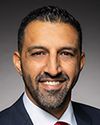That's good. I just wanted to make sure you guys were following up on that.
I see in the mandate letter that ports modernization is on the list. I did just want to put in a plug for the Sombra ferry dock, which got crushed, as you remember, by the Coast Guard ship and still is not in place. We've lost a border crossing. We've lost $4 million of economic activity on either side and $4 million of revenue for the CBSA, so don't forget the Sombra ferry when you do your ports modernization.
In my last bit of remaining time, I want to talk about airports. We also lost our airport service in Sarnia. Many rural communities across the country are in a similar state. Can you describe what the department is intending to do about those concerns?






